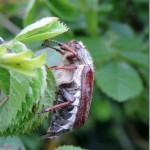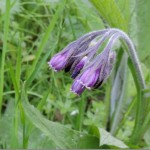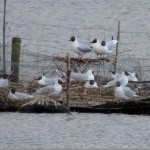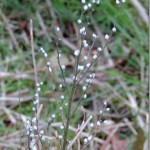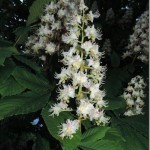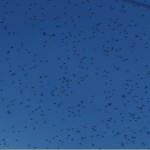John Lerpiniere led an evening walk on Tuesday 6th May at Hosehill Local Nature Reserve near Theale. While the group were gathering, a Sand Martin flew over the lake, then a Sparrowhawk flew over and was mobbed by Black-headed Gulls. The walk started out from the north side of the lake. A series of Song Thrushes sang loudly in the background throughout the evening. At the first bend, a big brown Cockchafer beetle was spotted in the hedge at the side of the path. The blossom was fully out on the Hawthorns of the reserve. A Grey Heron flew over and was also mobbed by the gulls. A single Reed Warbler was heard, together with a few Blackcaps and Garden Warblers. The group paused to look at the artificial Sand Martin bank. A small bird was flying in and out of one of the holes and, on closer inspection, turned out to be a Blue Tit. The walk continued round to the south side of the reserve. Two Nightingales were singing loudly in dense vegetation at the side of the path, then a little further on, a third bird was heard. A number of squares of roofing felt have been put down to provide refuges for snakes and small mammals. Several of these were sheltering small greyish-brown Field Voles and one had a young family. In an area known as the Butterfly Bank, the distinctive sprays of hard white seeds marked a Common Gromwell plant and a few more plants were found coming up nearby in a patch where scrub had been cleared back last winter.
Yellow Rattle was thriving in the meadow on the eastern side of the reserve. The Exmoor ponies from Greenham Common are brought to graze the meadow in the autumn and their hooves help to press the Rattle seeds into the ground. Also in flower were yellow Crosswort and Cowslips. There are more refuges in the meadow area and one was sheltering a Bank Vole family. The mother was larger and more ginger-coloured than the Field Voles. Hemlock Water-dropwort is increasing around the reserve, including in the meadow, possibly as a result of the prolonged flooding last winter. Continuing round the lake, a Great Crested Grebe was watched as it swam with head down, neck extended forwards and raised feathers on its back. Then another pair of grebes swam into view, also in the same posture – it appeared to be a territorial dispute. From deep in the reeds nearby came the explosive burst of song of a Cetti’s Warbler. The final section of the walk was across the road on the edge of Main Pit. Deep in the dense scrubby vegetation around the base of the pylon, perhaps 6 Nightingales were singing loudly. Then as the group walked back in the gathering darkness, an Oystercatcher flew overhead, calling loudly.
Recording of Nightingale song by Ian Duddle
Pictures by Rob Stallard

